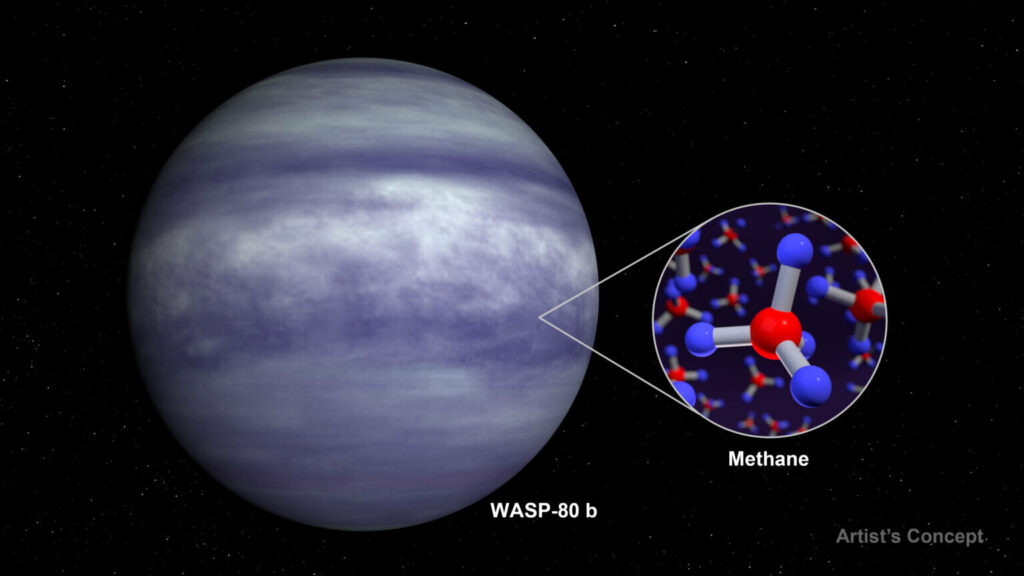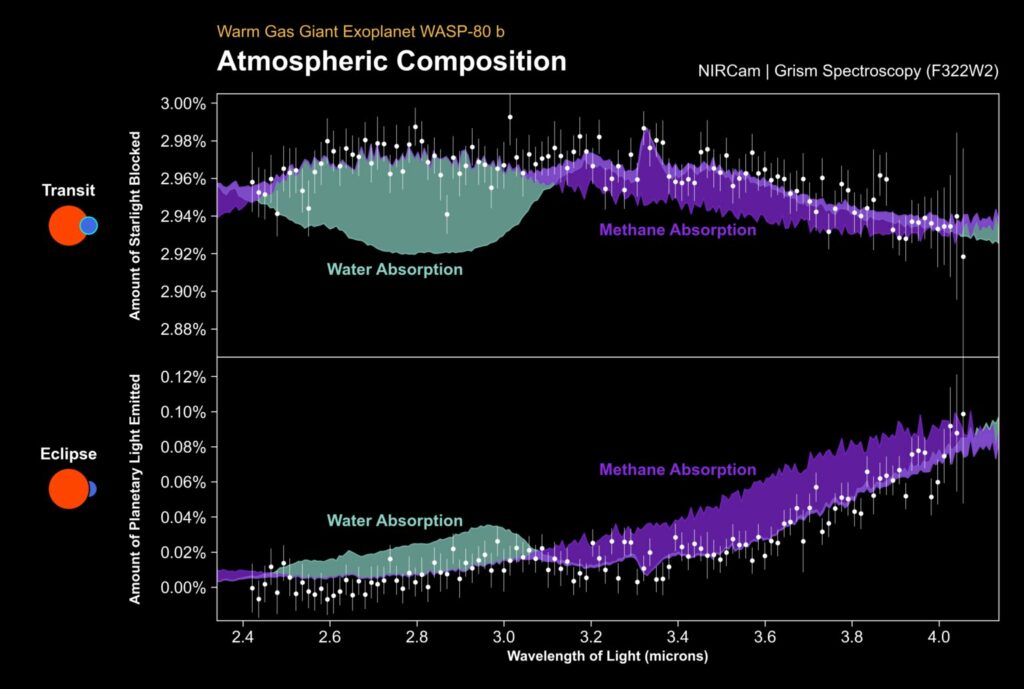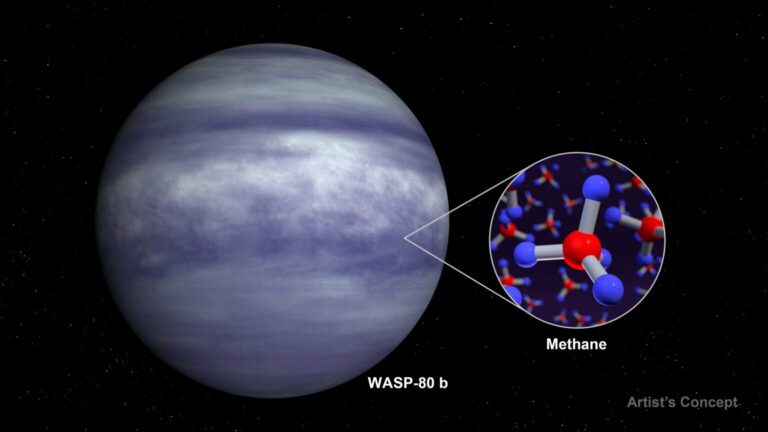Webb Detects Methane Presence in Exoplanet’s Atmosphere
The James Webb Space Telescope observed the exoplanet WASP-80 b as it passed in front of and behind its host star, revealing spectra indicative of an atmosphere containing methane gas and water vapor.
While water vapor has been detected in over a dozen planets to date, until recently, methane—a molecule found in abundance in the atmospheres of Jupiter, Saturn, Uranus, and Neptune within our solar system—has remained elusive in the atmospheres of transiting exoplanets when studied with space-based spectroscopy. Taylor Bell from the Bay Area Environmental Research Institute (BAERI), working at NASA’s Ames Research Center in California’s Silicon Valley, and Luis Welbanks from Arizona State University elaborate on the significance of discovering methane in exoplanet atmospheres and discuss how Webb observations facilitated the identification of this long-sought-after molecule. These findings were recently published in Nature.

“With a temperature of approximately 825 Kelvin (about 1,025 degrees Fahrenheit), WASP-80 b falls under the category of ‘warm Jupiters,’ planets that share similar size and mass with Jupiter in our solar system but possess temperatures intermediate between hot Jupiters, such as HD 209458 b (the first discovered transiting exoplanet) with a temperature of 1,450 K (2,150 F), and cold Jupiters like our own, which is about 125 K (-235 F).” “WASP-80 b completes an orbit around its red dwarf star every three days and is located 163 light-years away in the constellation Aquila.
Due to its close proximity to the star and their considerable distance from us, direct observation of the planet, even with advanced telescopes like Webb, is not possible. Instead, researchers employ the transit method, widely used in discovering exoplanets, and the eclipse method to study the combined light from the star and planet.” “Using the transit method, we observed the system during the planet’s passage in front of its star from our viewpoint, causing a slight dimming of the starlight—similar to the dimming when someone passes in front of a lamp.” “During this phase, a narrow ring of the planet’s atmosphere along the day/night boundary is illuminated by the star.
At specific wavelengths where molecules in the planet’s atmosphere absorb light, the atmosphere appears denser, blocking more starlight and resulting in a more pronounced dimming compared to wavelengths where the atmosphere is transparent. This method aids scientists in understanding the composition of the planet’s atmosphere by identifying the blocked colors of light.” “Conversely, using the eclipse method, we observed the system as the planet moved behind its star from our perspective, causing another minor dip in the overall received light.
All objects emit thermal radiation, with the intensity and color depending on their temperature.” “Just before and after the eclipse, the planet’s hot dayside faces us, and by measuring the light dip during the eclipse, we could gauge the infrared light emitted by the planet. In eclipse spectra, the absorption by molecules in the planet’s atmosphere typically manifests as a reduction in the emitted light at specific wavelengths. Additionally, since the planet is smaller and cooler than its host star, the eclipse depth is much smaller than the transit depth.”

“The initial observations required transformation into a spectrum, representing the extent to which the planet’s atmosphere either blocks or emits light at various colors or wavelengths. Numerous tools exist for this transformation, prompting us to utilize two distinct approaches to ensure the robustness of our findings under different assumptions.”
“Subsequently, we interpreted this spectrum using two types of models to simulate the appearance of a planet’s atmosphere under extreme conditions. The first model, highly flexible, tested millions of combinations of methane and water abundances and temperatures to identify the combination best aligned with our data. The second model, known as ‘self-consistent models,’ also explored millions of combinations but incorporated existing knowledge of physics and chemistry to determine expected methane and water levels.” “Both model types yielded the same result: a conclusive detection of methane.” “To validate our results, we employed rigorous statistical methods to assess the probability of our detection being random noise. In our field, a ‘5-sigma detection’ is considered the gold standard, indicating odds of detection being due to random noise at 1 in 1.7 million.
Remarkably, we detected methane at 6.1-sigma in both the transit and eclipse spectra, establishing odds of spurious detection in each observation at 1 in 942 million, surpassing the 5-sigma standard and bolstering our confidence in both detections.” “With such a high-confidence detection, we not only identified a highly elusive molecule but can now delve into understanding what this chemical composition reveals about the planet’s origin, growth, and evolution. For instance, measuring the methane and water levels allows us to infer the carbon-to-oxygen ratio.”
“This ratio is expected to vary based on the location and time of a planet’s formation. Thus, examining this carbon-to-oxygen ratio offers insights into whether the planet formed near its star or farther away before gradually migrating inward.” “Another aspect that excites us about this discovery is the opportunity to compare planets outside our solar system with those within it.
NASA has historically sent spacecraft to measure the methane and other molecules in the atmospheres of the gas giants in our solar system. Now, having a measurement of the same gas in an exoplanet enables a direct comparison, allowing us to assess whether expectations from our solar system align with observations beyond it.” “As we anticipate future discoveries with Webb, this result signals the brink of more exciting findings. Additional MIRI and NIRCam observations of WASP-80 b with Webb will enable exploration of atmospheric properties at different wavelengths. Our findings suggest that we may observe other carbon-rich molecules such as carbon monoxide and carbon dioxide, providing a more comprehensive understanding of conditions in this planet’s atmosphere.”
“Moreover, as we identify methane and other gases in exoplanets, we continue expanding our knowledge about the workings of chemistry and physics under conditions distinct from those on Earth, possibly shedding light on other planets that resemble our home. Clearly, the journey of discovery with the James Webb Space Telescope is teeming with potential surprises.”
This article is republished from PhysORG under a Creative Commons license. Read the original article.
Do not forget to share your opinion with us to provide you with the best posts !




0 Comments